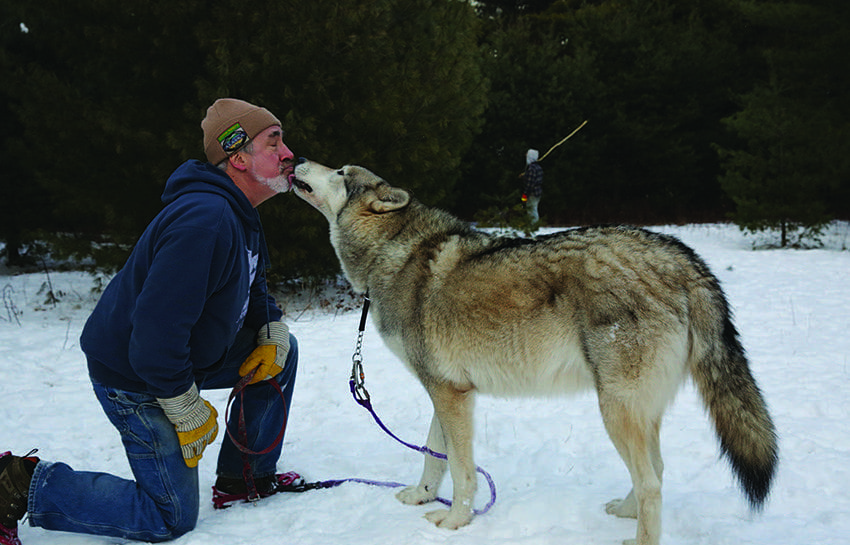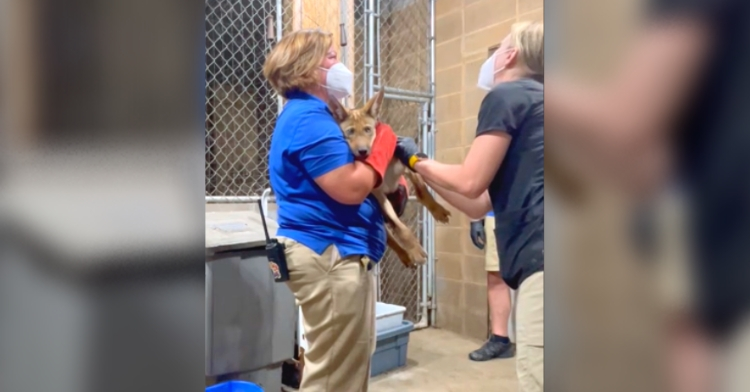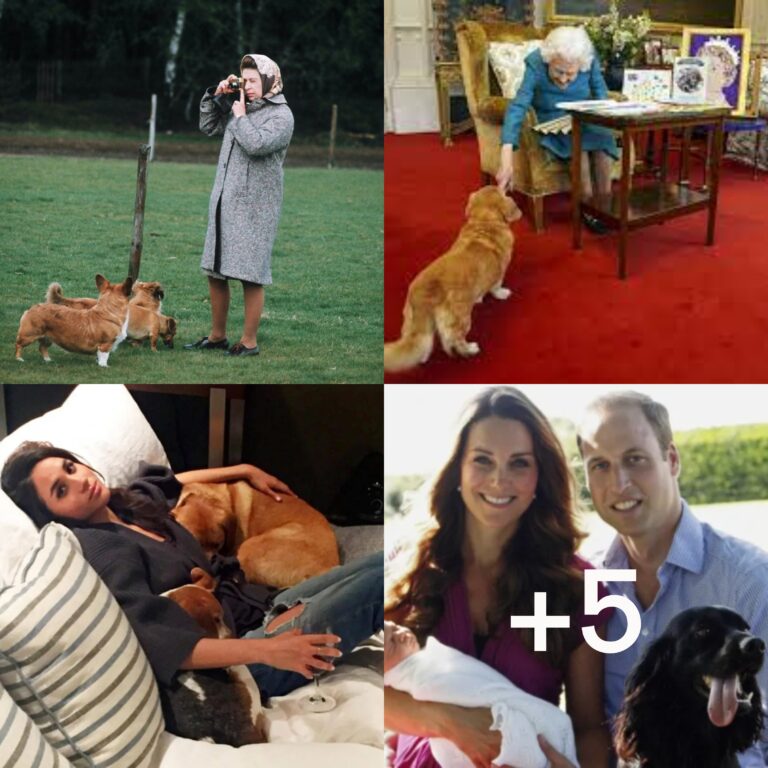The wolf at our door
Wildlife advocates believe wolves could come back to the Adirondacks someday and want the state to
facilitate their return.
Wilmington, a wolf lifts its head and howls, breaking the near silence on a cold winter day. Just a few feet away Steve Hall watches the scene, a leash in his hand.
The wolf on the other end of the leash is one of three owned by Hall and his wife, Wendy, a wildlife rehabilitator. The couple owns Adirondack Wildlife Refuge, and the animals are used for education, including popular “wolf walks.” During the walks, visitors hike with Hall and the wolves. Hall hopes the walks will give people a better understanding of animals that are commonly feared even though they rarely attack humans.
Hall yearns for a day that wild wolves return to the Adirondacks. He sees the wolf not only as filling an important role in the ecosystem as a keystone predator, but also as a tourist draw.
“We publicize the Adirondacks for summer hiking, fishing, hunting, winter sports, stuff like that, but also it could be a good place to see wildlife,” Hall said. “I think we should position the Adirondacks as another place to see wildlife a la Algonquin Park [in Ontario]. We’d start to open up to a whole new type of tourist.”
Hall is one of numerous wildlife advocates who are hoping state and federal wildlife agencies will work to facilitate the wolf’s return to the Northeast. Wolves disappeared from New York State around 1900 as a result of habitat destruction and unregulated hunting. Between 1871 and 1897, ninety-eight wolves were killed for bounties in the state, according to the U.S. Fish and Wildlife Service.
Gray wolves are listed as endangered in the Lower 48 states, but largely because they have made a comeback out west, the U.S. Fish and Wildlife Service has proposed delisting them. Wolves also are on New York State’s list of endangered species. In December, however, the state Department of Environmental Conservation dropped cougars, lynx, and wolves from its proposed list of Species of Greatest Conservation Need. In the past, extirpated species had been on that list, which is part of the state’s Wildlife Action Plan.
“We feel that our conservation work is better directed at retaining viable populations of the species that are currently present in New York,” said DEC biologist Joe Racette, coordinator of the Wildlife Action Plan.
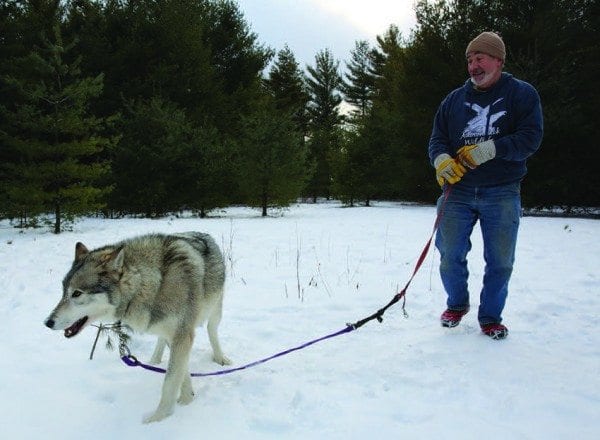
At this time, DEC has no interest in reintroducing wolves to the state. Gordon Batcheller, DEC’s chief wildlife biologist, told the Explorer that the department lacks the staff and funding to reintroduce or aid the recovery of large predators such as mountain lions and wolves. He also said the department already has its hands full with hundreds of other species in need of protection. Furthermore, he said reintroducing cougars or wolves would be a complex undertaking, requiring the cooperation of nearby states and support from a wide range of stakeholders.
“We just aren’t able to take this one on right now because it’s so huge,” he said. “We don’t have the capacity to deal with it, and it would take an awful lot of analysis and evaluation and public engagement before we even got out of the gate.”
Peter Nye, who headed the DEC Endangered Species Unit before retiring in 2010, said wolves didn’t have the public’s support in the 1990s, when there was a campaign to bring them back, and doubts that they do now. “We didn’t actively have any programs to even think about bringing wolves back,” Nye said. “It was just too contentious.”
Both Batcheller and Nye said wolves probably would migrate beyond the Adirondack Park to low-lying areas where deer are more plentiful. “That would immediately, of course, set up a problem for the animals in terms of people interactions,” Nye said.
Wolves are known to prey on livestock, and like other predators, they have a reputation for being dangerous to humans, even though only a handful of fatal wolf attacks have been recorded in North America.
Cristina Eisenberg, scientist for Earthwatch, an international nonprofit, lived in northern Montana and observed wolves recolonizing that area. “Wolves are not at all dangerous to humans in my experience,” she said.
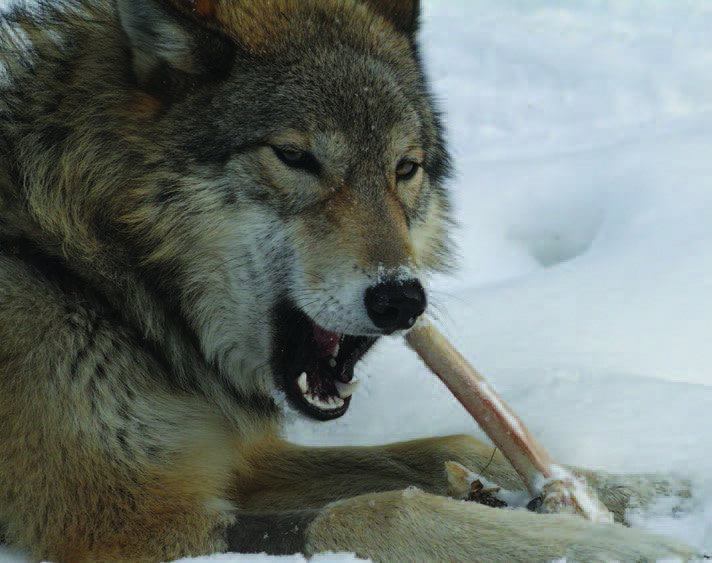
“I’ve been around hundreds of wild wolves at very close range and they don’t see us as prey.”
“The only wolves that are dangerous, that have been documented attacking or killing people, are wolves that are habituated by humans to human food,” she added.
Even if DEC won’t reintroduce wolves, wildlife advocates are hopeful that someday the predators will recolonize the Adirondacks on their own. Over the years, there have been a number of reported wolf sightings, but physical evidence has generally been lacking. Scientists did confirm that a wild wolf was killed in Day, north of the Great Sacandaga Lake, in December 2001.
Wolf populations have rebounded and expanded out west. In the Great Lakes region—Minnesota, Wisconsin, and Michigan’s Upper Peninsula—there are now 4,500 animals. And tens of thousands of wolves live in Canada.
“One of the amazing things about the past few years is all these animals—cougars or wolves or what have you—are just really showing us that their wildways do exist, these corridors, and most of these animals, they roam,” said Maggie Howell, executive director of the Wolf Conservation Center in downstate New York and coordinator of the Northeast Wolf Coalition, which was formed last year by scientists and environmental groups.
Wildlife advocates believe the wolf stands a better chance than the cougar of returning to the Adirondacks. Ontario’s Algonquin Provincial Park, which lies a couple of hundred miles to the northwest, has a few hundred wolves and even sponsors wolf howls for tourists. Wolves from Algonquin are the most likely to disperse to the Adirondacks, according to many observers. Nevertheless, there are obstacles.
“The eastern wolf is really close, but there is very aggressive hunting and trapping between here and Algonquin Park,” Howell said. In addition, wolves must cross numerous roads, including Highway 401 in southern Ontario, a fragmented landscape, and the St. Lawrence River.
Yet there is evidence that Canadian wolves can make it across the border. In addition to the animal killed in Day in 2001, two wolves were shot in Vermont’s Northeast Kingdom in 1998 and 2006, presumably after migrating south from Quebec.
“And these are only the ones we know of because we killed them,” said Eisenberg, who is writing a book on eastern carnivore conservation. “From what I know, this is the tip of the iceberg, that there are many more that are making their way down, likely down from Canada, although some may be dispersing from the upper Midwest.”
Evidently, New York State has plenty of habitat and prey to support a wolf population. The Eastern Wolf Status Assessment Report, prepared for the U.S. Fish and Wildlife Service in 2011, concluded that “sizeable areas of potential wolf habitat exists in this state, especially in the area of the Adirondacks.” The report refers to several studies that reached the same conclusion, including one that estimated that the state could have supported up to 460 wolves in 2000.
If wolves do return to the Adirondacks, one concern is that hunters will mistake them for coyotes and shoot them. Like many states, New York has a liberal coyote-hunting season, lasting from fall to spring. Moreover, the state allows hunters to kill an unlimited number of coyotes and doesn’t require hunters to report their kills.
The Northeast Wolf Coalition argues that one reason DEC needs a wolf-recovery plan is to protect dispersing wolves from coyote hunters.
“There is evidence that wolves have attempted to naturally recolonize the region,” Howell said. “But because states in the region sanction policies that encourage the unregulated killing of canids, this evidence is in the form of dead wolves. New York needs a management plan to address the potential return of wolves, to promote wolf recovery, educate the public, and have a plan in place to protect wolves from being killed accidentally or intentionally.”
In the 2005 version of the state’s Wildlife Action Plan, which is being updated, DEC took more interest in the wolf. The report noted that wolves from Algonquin Park range to within fifty miles of the New York border. The report also discussed the need for surveying public opinion about wolf recovery, adding that identifying the wolf as a Species of Greatest Conservation Need “will facilitate the evaluation.” DEC never conducted the survey, and Racette said it is not a high priority now.
“It is possible that wolves will be able to naturally expand their range to New York from nearby populations in Canada, and if that does occur we will conduct outreach to help people learn how to coexist with wolves,” Racette told the Explorer.
Howell says the Northeast Wolf Coalition hopes to conduct its own survey, but she couldn’t provide any details because it’s still in the early planning stages.
Wildlife advocates contend that if wolves return, they will have a beneficial impact on the environment. “In pretty much any system where you have active predation, you will have higher biodiversity than in one where you don’t. This has been observed in oceans, coral reefs, savannahs, worldwide in many different types of ecosystems,” Eisenberg said.
Yet scientists debate what, exactly, the wolf’s ecological role would be and which wolf would fill it. Because canids interbreed, the wolf gene pool has become complicated. Algonquin Park has some gray wolves, which are also found in the Great Lakes region, but the majority of them are smaller eastern wolves, which may or may not be a separate species. In addition, the eastern coyote, which lives in the Adirondacks, has some wolf genes as a result of interbreeding.
“Wolf taxonomy right now is a mess,” Eisenberg said. “The experts don’t agree about what an eastern wolf is.” Indeed, it’s uncertain what wolf originally lived in New York State.
In the Adirondacks, hybridization would likely occur between dispersing eastern wolves and the resident coyotes, according to DEC biologist Jenny Murtaugh. In contrast, scientists believe that gray wolves, such as those in the Great Lakes, do not breed with coyotes in the wild and displace them instead.
“Thus, dispersing gray wolves from Quebec and Ontario may have a higher probability of avoiding genetic swamping from eastern coyotes and establishing a viable population in New York,” Murtaugh wrote for the forthcoming Wildlife Action Plan.
Steve Hall, the owner of the Adirondack Wildlife Refuge, acknowledges that wolves may breed with coyotes in the Adirondacks, but he still argues that their presence would make the Park a wilder place.
“I don’t really go along with the idea that we have to have pure gray wolves, pure Canadian wolves,” Hall said. “We have an animal we call the coy-wolf, who is rather impressive and rather beautiful, and I think if we let wolves come back you’ll see larger coy-wolves.”
Hall said wolves would benefit the region economically, noting that tourists visit Algonquin Park, northern Minnesota, and Yellowstone Park to hear or see wolves.
In Yellowstone, where wolves were reintroduced in the mid-1990s, wolf tourism translates into $35 million a year in visitor spending, according to a 2006 report prepared for the Yellowstone Park Foundation.
Lake Placid resident Larry Master, a former chief zoologist for the Nature Conservancy and an Explorer board member, has visited Yellowstone Park to photograph wolves. “My god, I would love to hear wolf packs,” Master said. “People camp for weeks on end in late May, early June in camper vans with telescopes and spotting scopes with the hope of seeing a wolf, or wolf packs hunting. It’s an enormous economic boon for that area.”
